Pics of Bed Bug Eggs
When bed bugs enter your home, the first thing they do is find a good hiding place near you. Once in their hiding place, bed bugs will begin to reproduce and form a nest. Bed bug nests are made up of adult forms, nymphs, and especially, eggs. With the help of these pics of bed bug eggs, you will be able to correctly identify them and differentiate them from other eggs.
The Best Pics of Bed Bug Eggs
Males and females reproduce through a process called traumatic insemination. This is a traumatic process from which females must recover to have their eggs. Due to the traumatic nature of the process, some females do not fully recover and lay smaller eggs. Females should take time to heal well to produce more eggs. This is one of the reasons why the female prefers to hide in places where there are fewer males to mate with. A female bed bug can carry eggs for up to 7 weeks.
In the first image, we can see a group of eggs on a mesh. It can be seen that most of the eggs have hatched.
In order to reproduce, a female bed bug must ingest enough blood and thus acquire the necessary nutrients to lay her eggs. The female will begin to lay eggs approximately 3 days after ingesting her blood. Females lay an average of 5 eggs per week. However, the most fertile female bed bugs can lay up to 12 eggs per day. They do all this by feeding on your blood.
What Bed Bug Eggs Look Like?
Bed bug eggs are characterized by a translucent white color and measure on average 1 mm (0.039 in). That is the same as the size of a pinhead. They are generally found in clusters and are covered in a sticky substance that allows them to stick to any surface. They easily stick to wood or fabric surfaces.
In the second image, we can see a group of eggs on a table. You can see that they look like grains of rice, albeit smaller. The brightest eggs are those that have not yet hatched. Those with deformities are those that have already hatched.
Another characteristic of bed bug eggs is what is called the eyespot. Which corresponds to small reddish dots that can be seen inside the eggs. This corresponds to the bed bug developing inside the egg. This feature would confirm a possible infestation.
The third image shows some bed bug eggs seen through a magnifying glass. It is possible to clearly see the eyespot that indicates that there are bed bug nymphs inside.
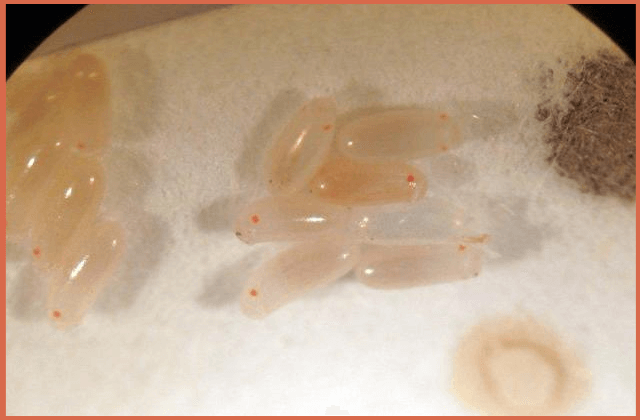
The eggs become increasingly bright and prominent as the nymph grows inside. When the nymphs hatch, the shells of the eggs suffer deformities and holes. They also look flatter and more opaque. Bed bug eggs hatch approximately 16 days after they are laid.
In the following image, we can see a lot of eggs hatched together with the nymphs. Adult-shaped exoskeletons can also be seen.

Where to find them?
They are commonly found on the bed frame, the headboard, under the bed, and between the seams of mattresses. You can also find them on old furniture, clothing, and in cracks or crevices in the wall or floor.
Other areas are inside electrical outlets, inside drawers, and similar to roaches, inside kitchen appliances. Their flat bodies can allow them to create a home in the most difficult-to-reach places.
In the fifth image, we can see bed bug eggs next to bed bug poop. Bed bug fecal matter looks like brown spots from digested blood.
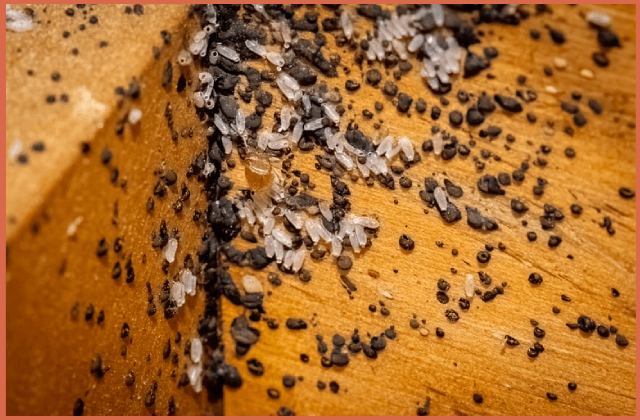
How do remove them?
The main measures to be taken are Review and Detection. Once the problem is detected, you must remove the entire nest. This includes removing adult forms, nymphs, and eggs.
If removing the nests, only the adult forms and nymphs are removed but the eggs are not removed, they can cause a re-infestation. Since these eggs can hatch again and start a new life cycle inside your room, generating a new progeny and in this way, a new infestation.
The image below shows bed bug eggs on a white wall. You can also see some drops of stool.
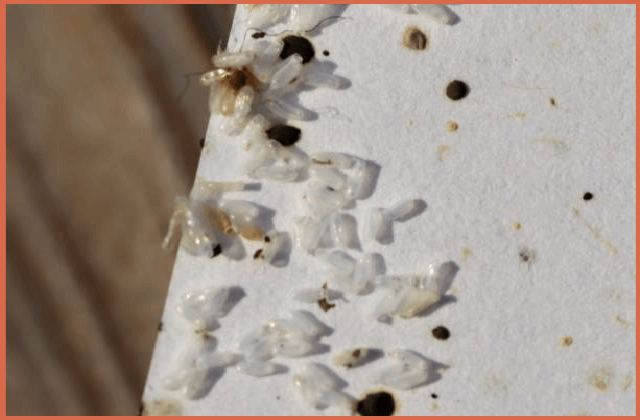
You should also check for the presence of hatched bed bug eggshells. This will also help you determine if there are newborn nymphs that are running away to hide and feed on your blood again.
By correctly recognizing bed bug eggs, you can determine if you need to undergo a new treatment to remove these insects. Especially if you’ve been using chemicals and the problem still persists.
The seventh image shows a pile of bed bug eggs on a mat. You can see that most of the eggs are empty. In addition, you can see newborn nymphs and a large nymph in its second stage of development.

So, when deciding to eliminate bed bugs, it is important to eliminate the eggs entirely as well. Due to the sticky secretions that come with the eggs, they are sure to stay in place unless you find and kill them before they hatch.
Pictures of Bed Bug Eggs and Nymphs
As we have seen in previous posts, the adult forms of bed bugs are reddish-brown in color. The female has a rounded body and the males have an elongated abdomen. While nymphs are smaller and have a yellowish-white color.
In the following image, we can see several eggs together with the newly hatched nymphs. Note that some nymphs are hatching at the time the photo is taken.
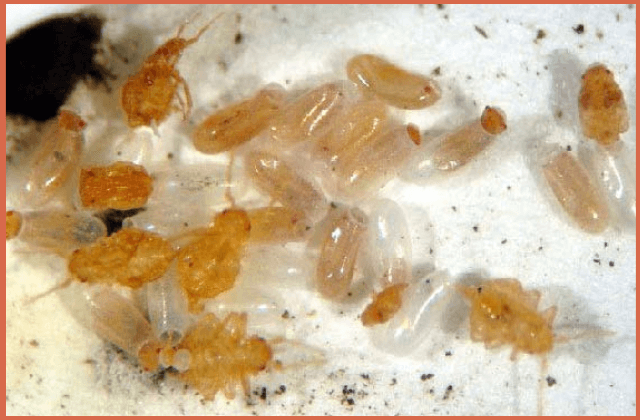
Although an adult bed bug can go up to 1 year without being fed, nymphs need to feed at least once a week to successfully mature into an adult. During a year, bed bugs can produce up to 3 generations.
The ninth image shows a pile of bed bug eggs on wood. You can see that some eggs are empty and bulls haven’t hatched yet. Nymphs can also be seen.

Treatments to Eliminate Bed Bug Eggs
Heat treatment
One way to effectively kill the eggs is through the use of heat treatment. We recommend drying the clothes with the help of a drying machine and using a steam cleaner for the bed and furniture.
Chemical treatments
There are a large number of pesticides on the market to kill bed bugs. Some of them are capable of removing eggs as well. Diatomaceous earth can be helpful in eliminating remaining adult forms and nymphs. The degree of success will depend on the degree of infestation.
Homemade or DIY treatments
Other home treatments include putting bed bug traps around the room, as well as pots of water on each bed base to keep them from crawling over there.
Finally, and although bed bugs are not directly related to poor hygiene conditions, it never hurts to vacuum, pick up clutter, and clean surfaces well. You can also easily disinfect surfaces with the help of a chlorine-based product. They are quite inexpensive and very efficient.
The last image is magnified several times. In this image, we can see hatched bed bug eggs, as well as droplets of excrement.
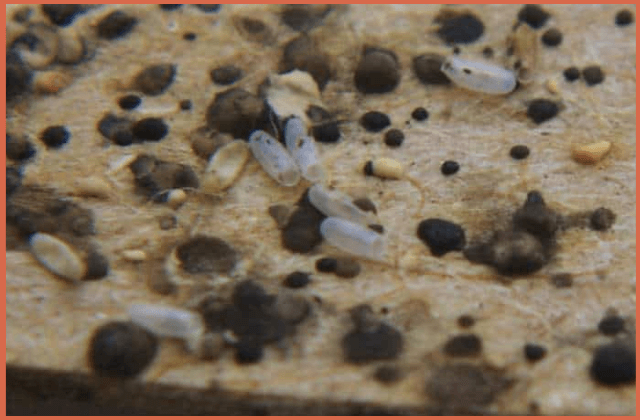
Remember, the most effective way to eliminate bed bugs completely is to follow all the treatments together. Since you will not eliminate bed bugs if you don’t combine all the treatments mentioned above.
If the problem persists, it is recommended to seek professional help. Professionals will bring industrial-size heaters into your home to raise the temperature for several hours. This treatment is extremely effective but it is also expensive. It should be used only in cases of moderate or severe infestations.
Conclusion
When removing a colony of bed bugs, it is also necessary to remove the eggs to avoid re-infestation. Bed bug eggs are usually found in clusters and covered in a sticky substance to adhere to any surface. With these pics of bed bug eggs, you will be able to identify them more easily. necessary to carry out different treatments together to eliminate bed bugs and their eggs completely. Heat treatments are the most effective in eliminating bed bug eggs.
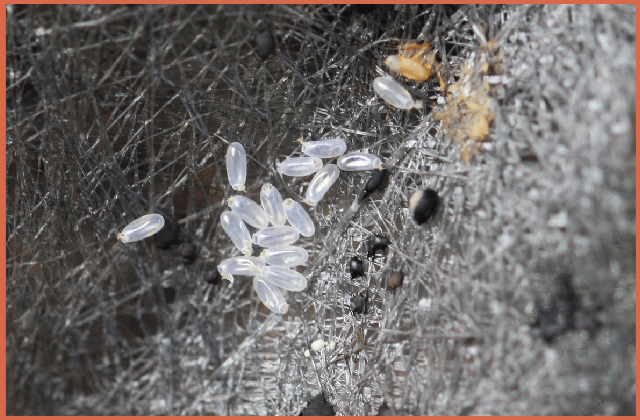
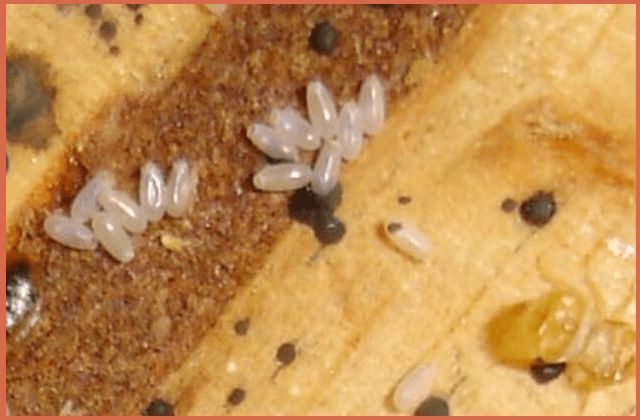


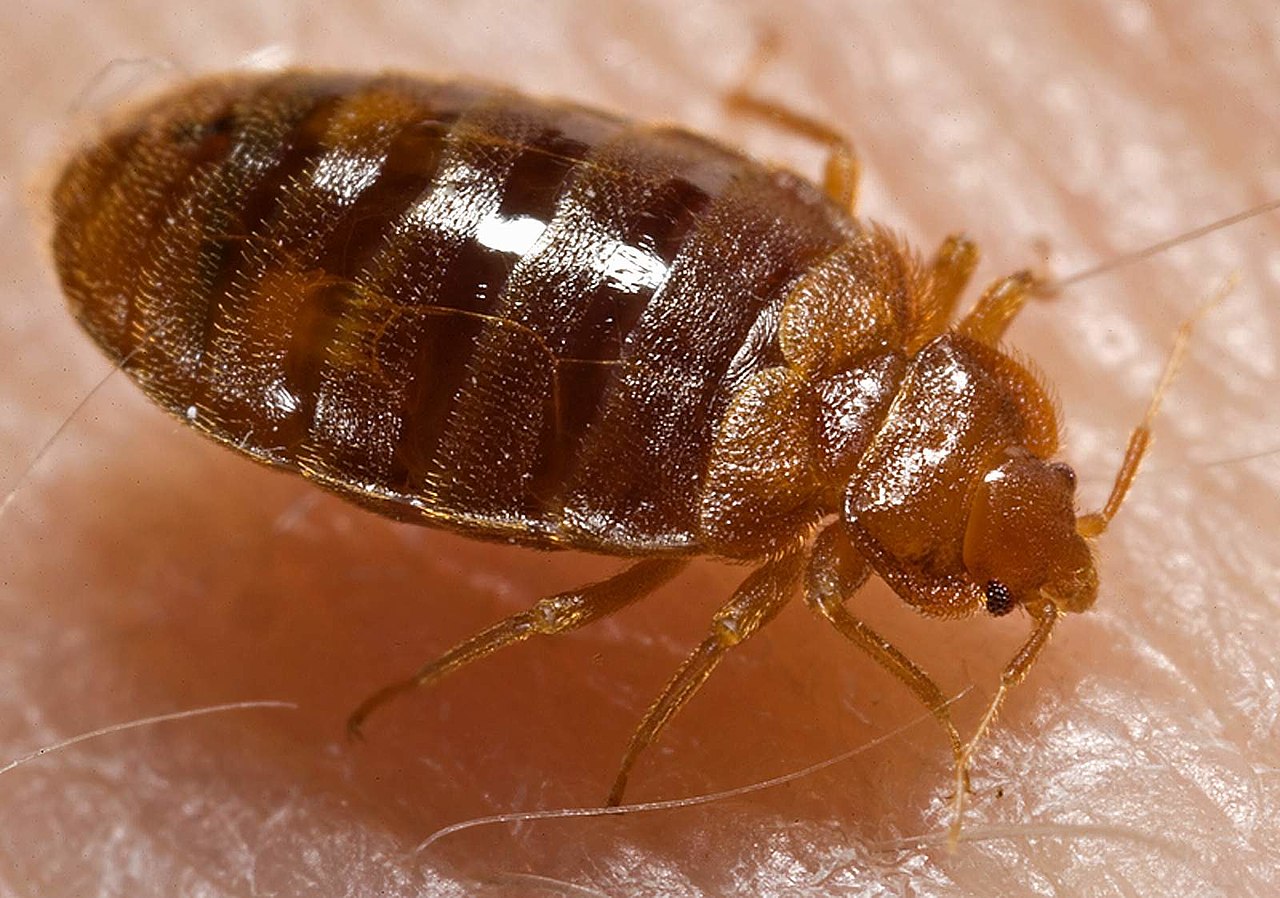
thank you so much we have had 3professional i am still gettig bit bext treetment in 2 weeks i am so tired every day we wash clothes bedding towels. on hot water use one bag for dirty and a new bar for clean